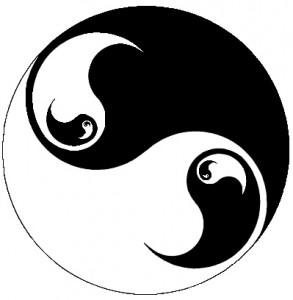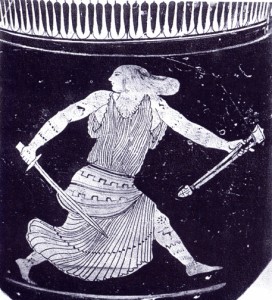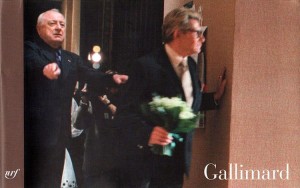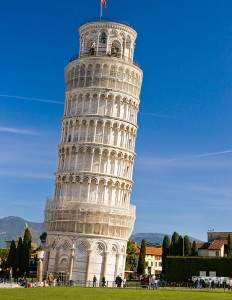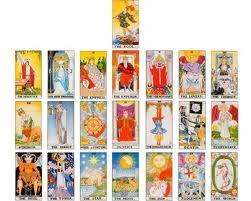Hathor – Goddess of Love, Pleasure, Beauty, Sensuality, and Romance – Emerges This Week!

A water garden soothes our spirit and our senses.
Have you been longing to bring more lushness into your life?
Do you desire sensuality, opulence, lusciousness to ooze from your every pore?
Have you been working so hard that your inner self has felt sterile and neglected?
It’s Not You; It’s Your Masculine Power Archetypes
Let’s play – just for a moment – with the notion that there may be something to this archetypal stuff after all.
For the past six months, we’ve been under the dominion of two masculine elemens: Air and Fire.
With the Vernal Equinox, six months ago in March, the element of Air took over in our lives, and ushered in the two most powerful (and power-focused) masculine archetypes: our visionary and creative Magician, and our sustaining and stabilizing Emperor.
These two archetypes can sometimes work in tandem, although they have different agendas. Often, successful businesses are built around a creative Magician/Emperor partnership.
When summer came, the influence of these two archetypes eased, and two new – although still very masculine – archetypes emerged: our inner Green Man and our Hierophant. Our Green Man, coming right after Summer Solstice, embodies our desire to join with nature. It makes sense that he is dominant just then – during the time that we are most likely to schedule vacations.
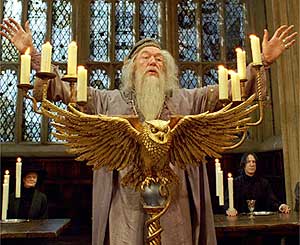
Professor Dumbledore welcomes students back to the academic year at Hogwarts.
Our Hierophant is our “back-to-school” archetype. He’s our Yoda; our Obi-wan Kenobi. He’s our Mr. Miyagi, telling us to “Wax on, wax off.” He’s our internal Professor Dumbledore, welcoming us back for the school year.
Our Hierophant officially emerged at Lammas (August 1st), and will reign through the remainder of this week (through September 21st).
Our Hierophant has one of the most important jobs within our inner psyche.
Yes, he embodies our inner mentor, guru, and guide. He’s the one who helps us take on the necessary self-discipline to master our inner selves. And of course, any time that we mentor someone else, we’re invoking our inner Hierophant.
But there’s one more thing that our Hierophant does.
He both protects and shelters our inner Hathor (who is as delicate and fragile as a newly-budded rose), and he gives her structure and boundaries. He both helps create the play-time for her (and holds the bounds fast against our other archetypes who want to gobble up her time), and yet keeps her from raging into temper tantrums and turning over all the apple carts in sight.
Our Inner Hathor: Wild, Willful, and Wonderful
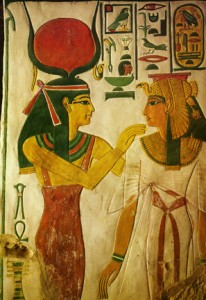
Hathor (left) welcomes the Egyptian queen Nefertari (right) to the afterlife. Image taken from an excellent ‘virtual tour’ of Nefertari’s tomb, led by ‘tour guide’ Professor Peter Schmidt of Swarthmore College.
Our inner Hathor is a lovely creature. And she, herself, is all about love.
But she is a bit on the wild and carefree side.
Just like a precocious teenager, who wants what she wants when she wants it – no matter how good (or how bad) it is for her – our Hathor is willful and bold. She wants her own way.
And way too often, we feel that we have to slight her and shut her down, simply because of survival concerns.
I’m not sure which of these is worse: Our survival-angst (all too often based on all-too-real concerns), or the power-mongering amongst our other (typically Magician/Emperor) core power archetypes that simply want to take our Hathor time – simply because they want it. Because it’s a resource, and they each want every resource that they can get.
This leads to: Power struggles.
The Biggest Power Struggles are Inside Ourselves
Power wars more dominant inside ourselves than they are on any Board of Directors, for any company in the world.
The reason?
Each internal archetype is like a person, all in itself. Each wants what he or she thinks or feels is best. Each wants to set the agenda.
The end result? We have huge internal struggles going on about the basics of our life. Do we spend the weekend on a project that will advance our creative passion or our career (Magician or Emperor), or are we going off camping? (That would be our Green Man, wanting to make a break for freedom.)
The Real Challenge
The real challenge that we face – especially as women – is that our core feminine archetypes are valued less by society than are our masculine ones.
Straightforward, isn’t it?
Masculine roles – involving creative outputs, legendary accomplishments, and forming business empires – are given attention, money, and reward by society.
In contrast, as a culture, we give less attention to the feminine roles of nurturance (Empress), introspection (High Priestess), creating a calm, peaceful and orderly environment (Hestia), and – of course – passion and play (Hathor).
To a very large extent, we’ve each internalized social values.
Add to that, it is often our masculine expression that pays the bills. That is, our masculine roles – more often than not – give us survival. (There are exceptions; some of us make our living through nurturing others; some of us live a life devoted to contemplation and prayer, and some of us are professional housekeepers or are in professional support roles. But these livelihoods – while real – make far less money than do the more masculine-oriented roles.)
The Most Pivotal Time of the Year
We’re now at the time when our Hathor is coming out to play.
For us to successfully create Hathor-time requires (surprise!) the discipline, clarity, and focus of our masculine archetypes – most especially our Hierophant.
We’re going to call on him to create boundaries; boundaries that will protect and cherish and value our inner Hathor.
Think of our Hierophant as a wise old gardener. He sees and loves a truly special rose.
This rose can’t be moved; she is deeply rooted in where she is. She is exquisite, but delicate and fragile.

Our Hierophant protects our inner Hathor by creating boundaries that give her safe enclosure – her own . Photo by Eileen Porterfield.
How will he protect her?
He builds a wall around her. He builds her her very own secret garden.
He creates structures to protect her from harsh winds.
He ensures that she’s fed and watered and tended on a regular basis.
For us to cultivate our own inner Hathor, we also have to be our own Hierophant-Gardener. We have to take on creating time, space, and attention for her. We have to give her permission to come out. We have to give her encouragement to flourish and play.
This is one of the most important tasks in our growth as full and complete human beings.
Much love to you, darling, as we enter this season of pleasure together!
To your own health, wealth, success, and overall well-being –
Alay’nya (Alianna J. Maren, Ph.D.)
Author of Unveiling: The Inner Journey
You are the Jewel in the Heart of the Lotus. Become the Jewel!
Check out Alay’nya’s YouTube Channel
Connect with Alay’nya on Facebook
Follow Unveiling: The Inner Journey on Facebook
This blog series develops themes originally published in Unveiling: The Inner Journey, published by Mourning Dove Press.
Unveiling currently has twenty 5-star Amazon reviews, and has been recommended by luminaries:
- Dr. Christiane Northrup – “This book is delightful”
- Midwest Book Review, in Bethany’s Books – reviews by Susan Bethany – “highly recommended”
- Nizana al Rassan, writing for (the now out of circulation) iShimmy.com – “a fascinating read with so much wisdom and solid advice.”
P.S. What can you read that will help you understand yourself more?
Julie Marie Rahm, America’s Mindset Mechanic
Check out Julie Marie Rahm!
Julie Marie Rahm, America’s Mindset Mechanic and author of Handle Everything: Eight Tools You Need to Live Well and Prosper and also Military Kids Speak (great for parents, teachers, and coaches of military kids) uses a great technique that can help you clear energy blockages, ranging from those from this life through the influence of your ancestral karma. Connect with Julie at info (at) americasmindsetmechanic (dot) com to learn more about how she can help you.
Books by Julie Marie Rahm, America’s Mindset Mechanic
|
Kindle
|
Kindle
|
|||
Julie Marie Rahm, aka America’s Mindset Mechanic on Unveiling: The Inner Journey
What does Julie Rahm, America’s Mindset Mechanic and author of Handle Everything: Eight Tools You Need to Live Well and Prosper have to say about Unveiling: The Inner Journey?
Julie writes:
[In Unveiling: The Inner Journey,] Alay’nya takes readers on an adventure of the body, mind, and spirit from the inside out, strengthening each independently from the other and aligning all three in support of each other. And then, the adventure continues as readers learn how to create the physical environment that supports and reflects the body, mind and spirit, from personal style to the home and office. Each chapter finishes with Personal Pathworking exercises. When readers choose to stop and do the exercises, opportunities for instant positive changes result.
Read this and more reviews of Unveiling: The Inner Journey.
|
Paper
|
Kindle
|
|||
Copyright (c) 2013, Alay’nya (Alianna J. Maren, Ph.D.). All rights reserved.
Related Posts: Hathor – Leading Up to This Point
Related Posts: Hierophant – Hathor’s Protector
- Our Hierophant: Mentor, Protector, and Guide for Our Love-Goddess Hathor
- Hathor or Hierophant – Who’s On Top?
- The Hierophant as Guru/Guide (also deals with Hierophant/Hathor Connection)
- Are Hierophants Really That Important? (McDonald’s Thinks So!)
- Who – and What – Is a Hierophant?
- The Hero’s Quest and the Hierophant – Part 1



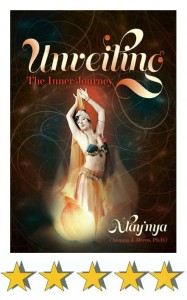
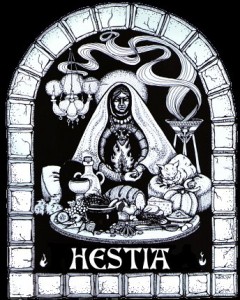
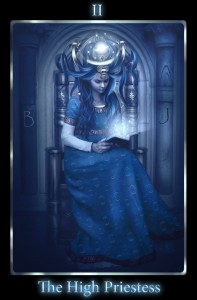
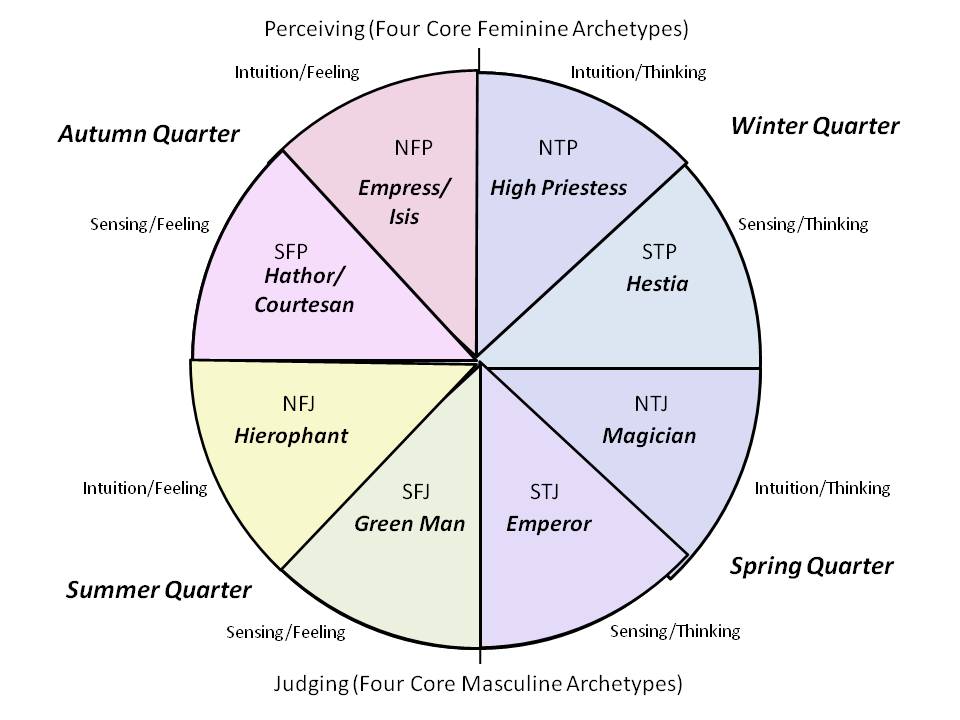



.jpg)
